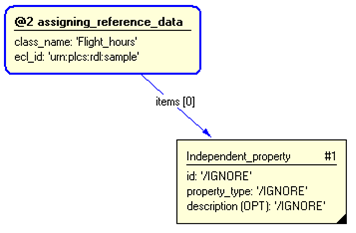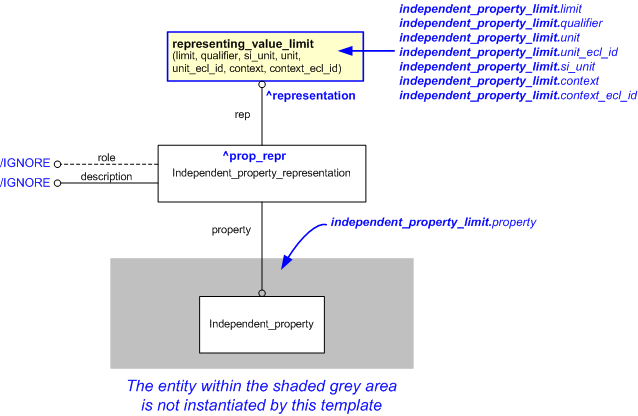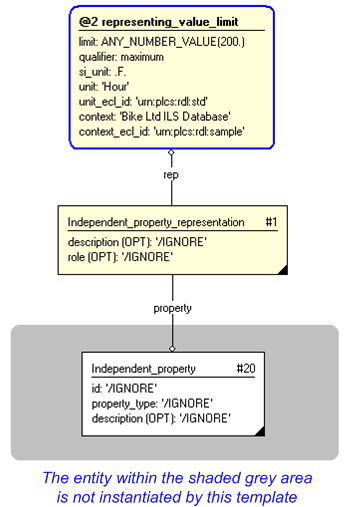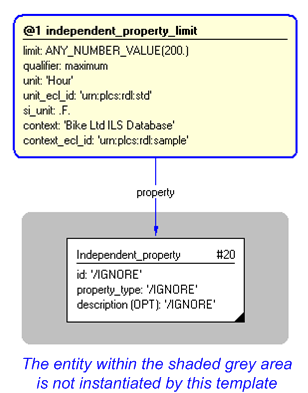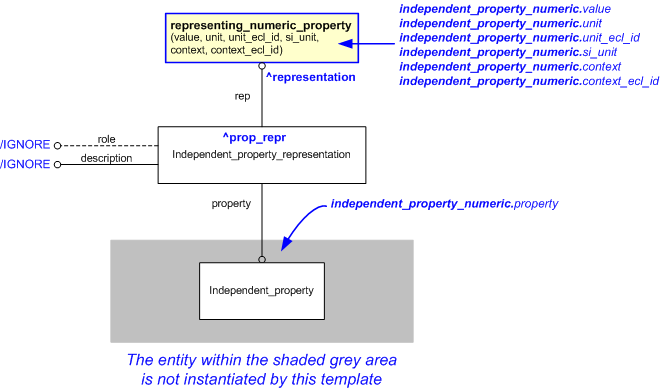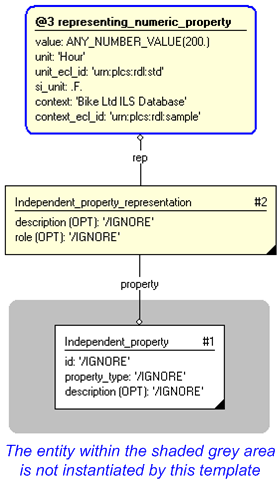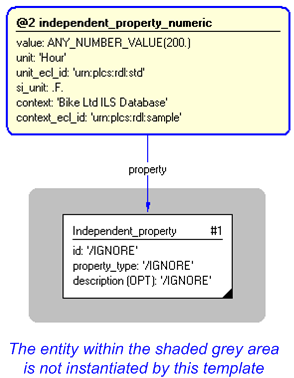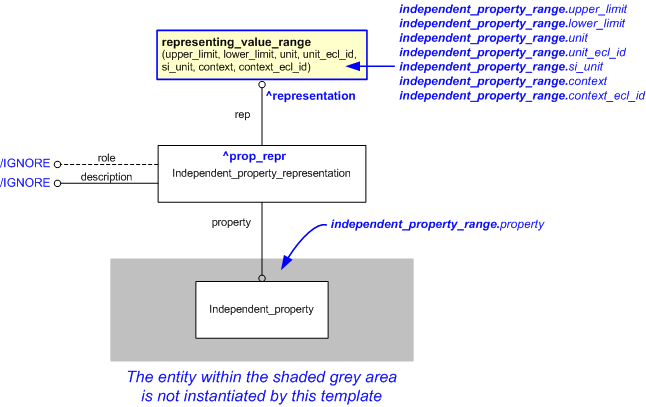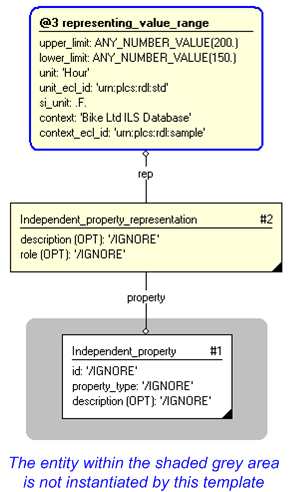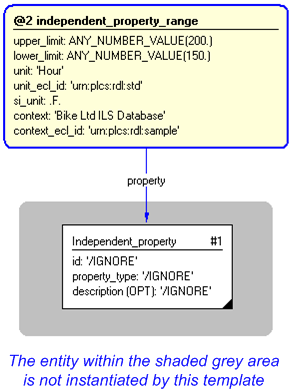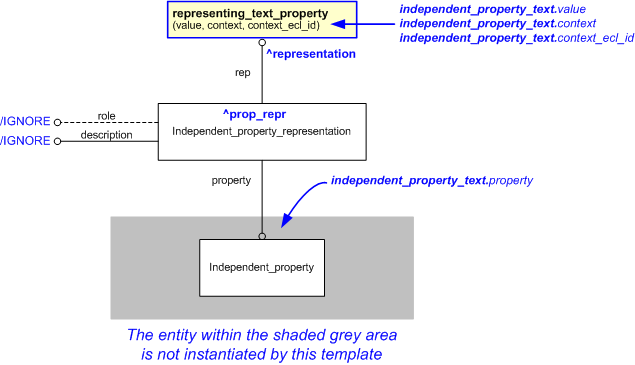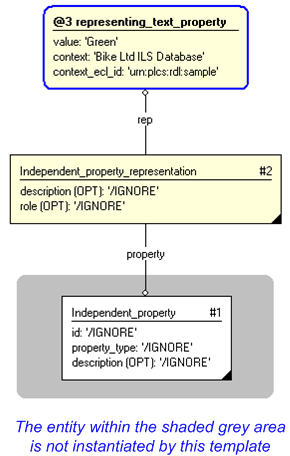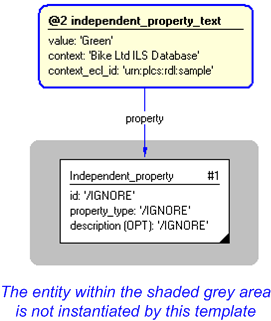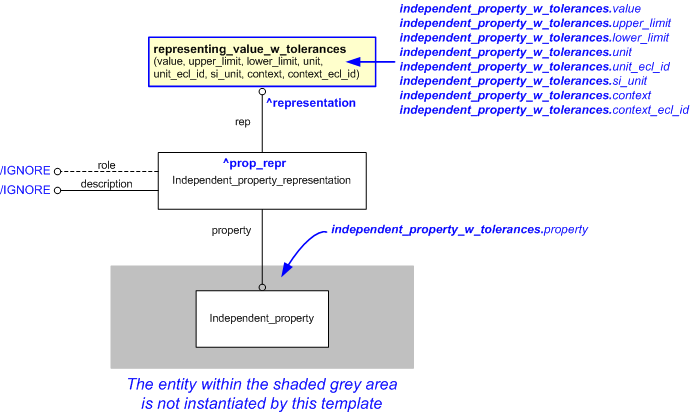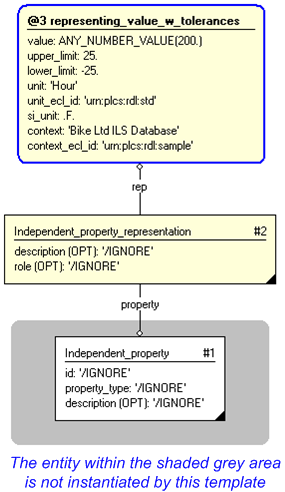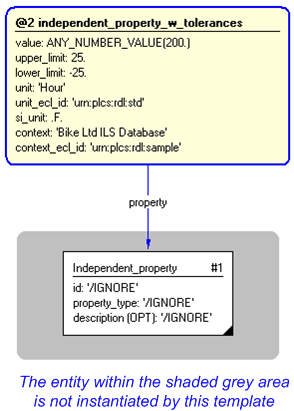| Capability (C097):— representing_independent_property |
Date: 2007/08/31 06:52:28
Revision: 1.2
|
This section provides a business level overview of this capability.
@@@@business_overview @@@@
This section provides an overview of the information model that supports
this capability.
@@@@information_model_overview@@@@
The EXPRESS-G for representing @@@@@@@ is shown in Figure 1.
below and explained in the following sections.
Figure 1 — Information model overview
This section specifies how the information model can be further
characterized by the assignment of additional information such as
dates, approvals and people or organizations.
The following characterizations may apply.
The following sections define a set of templates for the capability,
where a template is a specification of a set of entities that need to
be instantiated to represent a given set of information.
This section specifies the template representing_independent_property.
NOTE
An explanation of a template and the associated instantiation path is
provided in the
Template overview
section.
The EXPRESS-G diagram in
Figure
1
shows the templates and EXPRESS entities that are required
to represent the template
"representing_independent_property".
The text highlighted in blue shows the template parameters.
Figure 1 — An EXPRESS-G representation of the Information model for representing_independent_property
The graphic for the template to be used in other EXPRESS-G diagrams
is shown in Figure
2
below.
Figure 2 — The graphical representation of the representing_independent_property template
The following input parameters are defined for this template:
The class name corresponding to the property name.
The following classes and their sub-classes can be used:
The identifier of the
External_class_library
storing the definition of the class referenced by the parameter @property_class_name.
The following reference parameters are defined for this template:
Allow the
Independent_property
entity instantiated in this path to be referenced when this template is used.
%^target = $representing_independent_property.property%
The following parameter combinations specify a uniqueness constraint:
Unique constraint: Independent Property
Each instance of the
entity
(
Independent_property)
within the data set shall be uniquely identified
by a combination of the following parameters on this
template (representing_independent_property) namely:
property_class_name,
property_ecl_id.
The
instance is
referenced by the following template parameter:
property.
The instantiation path shown below specifies the entities that are to be
instantiated by the template.
The following entities are instantiated with attributes as specified:
The instance diagram in Figure
3
shows an example of the EXPRESS entities and templates that are instantiated by the template:
/representing_independent_property(property_class_name='Flight_hours', property_ecl_id='urn:plcs:rdl:sample')/
(an illustration of the consolidated representing_independent_property template is shown in
Figure
4 below.)
Figure 3 — Entities instantiated by representing_independent_property template
The instance model in STEP ASCII exchange file format (ISO 10303 Part
21 syntax) is:
#1 = INDEPENDENT_PROPERTY('/IGNORE','/IGNORE','/IGNORE');
#3 = CLASSIFICATION_ASSIGNMENT(#5,(#1),'/IGNORE');
#5 = EXTERNAL_CLASS('/NULL','Flight_hours','/IGNORE',#6);
#6 = EXTERNAL_CLASS_LIBRARY('urn:plcs:rdl:sample',$);
The instance diagram in
Figure
4
shows the graphic symbol for the template that is to be
used in other instance diagrams. The example template is:
/representing_independent_property(property_class_name='Flight_hours', property_ecl_id='urn:plcs:rdl:sample')/
Figure 4 — Instantiation of representing_independent_property template
No common characterizations of the template
representing_independent_property
have been identified. However, the ISO 10303-239 EXPRESS model
may enable other assignments to the entities instantiated by the template.
This section specifies the template independent_property_limit.
NOTE
An explanation of a template and the associated instantiation path is
provided in the
Template overview
section.
This template describes how to represent a numerical value with limit for an independent property.
The EXPRESS-G diagram in
Figure
1
shows the templates and EXPRESS entities that are required
to represent the template
"independent_property_limit".
The text highlighted in blue shows the template parameters.
Figure 1 — An EXPRESS-G representation of the Information model for independent_property_limit
The graphic for the template to be used in other EXPRESS-G diagrams
is shown in Figure
2
below.
Figure 2 — The graphical representation of the independent_property_limit template
The following input parameters are defined for this template:
The value of the property. The datatype is always 'any_number_value'
and should not be registered together with the value, i.e. enter the
value as a number, without datatype.
The limit qualifier of the property. Allowed values are 'maximum' or 'minimum'
The name of the unit in which the value is expressed, referenced through an
External_class.
The following classes and their sub-classes can be used:
The identifier of the
External_class_library
storing the definition of the unit name referenced by the parameter @unit.
Value should be set to true if the unit is a SI base unit defined by ISO, i.e.
kilogram (kg) for Mass,
second (s) for Time,
metre (m) for Displacement,
ampere (A) for Electrical current,
kelvin (K) for Temperature,
mole (mol) for Amount of substance, and
candela (cd) for Luminous intensity. If this is not the case it should be set to false.
Note that the representation of true and false depends on exchange format. In Part 11 (a STEP file) true is
represented by the string ".T.", and false by ".F.", while in Part 28 (XML) they are represented by text strings
"true"
and "false".
context (Default=Numerical_representation_context,Type='CLASS')
The following classes and their sub-classes can be used:
The identifier of the
External_class_library
storing the definition of the class referenced by the parameter @context.
The following reference parameters are defined for this template:
%^target = $independent_property_limit.prop_repr%
%^target = $independent_property_limit.representation%
The instantiation path shown below specifies the entities that are to be
instantiated by the template.
-- Instantiate Independent_property_representation entity Independent_property_representation-- Bind the Independent_property_representation entity to reference parameter ^prop_repr %^prop_repr =
Independent_property_representation%
-- Set the Independent_property_representation attributes role and description to be ignored Independent_property_representation.role = '/IGNORE'
Independent_property_representation.description = '/IGNORE'
-- Instantiate template representing_value_limit /
representing_value_limit(
limit=@limit,
qualifier=@qualifier,
unit=@unit,
unit_ecl_id=@unit_ecl_id,
si_unit=@si_unit,
context=@context,
context_ecl_id=@context_ecl_id)/
-- Bind the Independent_property_representation entity instantiated in the template representing_value_limit -- to ^representation in this template and assign Independent_property_representation.rep to it %^representation = $representing_value_limit.representation%
^prop_repr.rep ->
^representation
-- Assign value with limit to property
^prop_repr.property ->
@property
The following entities are instantiated with attributes as specified:
The instance diagram in Figure
3
shows an example of the EXPRESS entities and templates that are instantiated by the template:
/independent_property_limit(limit='any_number_value(200)', qualifier='maximum', unit='Hour', unit_ecl_id='urn:plcs:rdl:std', si_unit='false', context='Bike Ltd ILS Database', context_ecl_id='urn:plcs:rdl:sample', property='#20')/
(an illustration of the consolidated independent_property_limit template is shown in
Figure
4 below.)
Figure 3 — Entities instantiated by independent_property_limit template
The instance diagram in
Figure
4
shows the graphic symbol for the template that is to be
used in other instance diagrams. The example template is:
/independent_property_limit(limit='any_number_value(200)', qualifier='maximum', unit='Hour', unit_ecl_id='urn:plcs:rdl:std', si_unit='false', context='Bike Ltd ILS Database', context_ecl_id='urn:plcs:rdl:sample', property='#20')/
Figure 4 — Instantiation of independent_property_limit template
The following section details how the
independent_property_limit
template can be optionally characterized by assigning
other constructs to it. These are characterizations commonly
applied to the template. The ISO 10303-239 EXPRESS model may enable
other assignments to the entities instantiated by the template.
The following characterizations may apply:
Characterization Effectivity
NOTE this characterization is optional.
A property value for a defined property might just be effective under specific conditions.
Effectivity is represented by assigning an effectivity to the
Independent_property_representation
using the assigning_effectivity template.
AP239 Issue (GYL-5)
The ISO-10303-239 1st edition does not support the assignment of Effectivity_assignment to an
Independent_property_representation.
This has been raised as issue,
GYL-5, against ISO
10303-239. The EXPRESS schema has been modified in DEXlib (Long form: dexlib/data/schemas/ap239_arm_lf.exp,
short form: dexlib/data/schemas/ap239_arm_sf.exp).
These changes will be made to ISO 10303-239 as a Technical Corrigendum at
some stage.
This section specifies the template independent_property_numeric.
NOTE
An explanation of a template and the associated instantiation path is
provided in the
Template overview
section.
This template describes how to represent a numerical value with unit for an independent property
EXAMPLE
The number of engine starts.
The EXPRESS-G diagram in
Figure
1
shows the templates and EXPRESS entities that are required
to represent the template
"independent_property_numeric".
The text highlighted in blue shows the template parameters.
Figure 1 — An EXPRESS-G representation of the Information model for independent_property_numeric
The graphic for the template to be used in other EXPRESS-G diagrams
is shown in Figure
2
below.
Figure 2 — The graphical representation of the independent_property_numeric template
The following input parameters are defined for this template:
The value of the property. The datatype is always 'any_number_value'
and should not be registered together with the value, i.e. enter the
value as a number, without datatype.
The name of the unit in which the value is expressed, referenced through an
External_class.
The following classes and their sub-classes can be used:
The identifier of the
External_class_library
storing the definition of the unit name referenced by the parameter @unit.
Value should be set to true if the unit is a SI base unit defined by ISO, i.e.
kilogram (kg) for Mass,
second (s) for Time,
metre (m) for Displacement,
ampere (A) for Electrical current,
kelvin (K) for Temperature,
mole (mol) for Amount of substance, and
candela (cd) for Luminous intensity. If this is not the case it should be set to false.
Note that the representation of true and false depends on exchange format. In Part 11 (a STEP file) true is
represented by the string ".T.", and false by ".F.", while in Part 28 (XML) they are represented by text strings
"true"
and "false".
context (Default=Numerical_representation_context,Type='CLASS')
The following classes and their sub-classes can be used:
The identifier of the
External_class_library
storing the definition of the class referenced by the parameter @context.
The following reference parameters are defined for this template:
%^target = $independent_property_numeric.prop_repr%
Allow the
Representation
entity instantiated in this path to be referenced when this template is used.
Note: The
Representation
entity can be referenced in a template path by:
%^target = $independent_property_numeric.representation%
The instantiation path shown below specifies the entities that are to be
instantiated by the template.
-- Instantiate Independent_property_representation entity Independent_property_representation-- Bind the Independent_property_representation entity to reference parameter ^prop_repr %^prop_repr =
Independent_property_representation%
-- Set the Independent_property_representation attributes role and description to be ignored Independent_property_representation.role = '/IGNORE'
Independent_property_representation.description = '/IGNORE'
-- Instantiate template representing_numeric_property /
representing_numeric_property(
value=@value,
unit=@unit,
unit_ecl_id=@unit_ecl_id,
si_unit=@si_unit,
context=@context,
context_ecl_id=@context_ecl_id)/
-- Bind the Independent_property_representation.rep to the Representation -- entity instantiated in the template representing_numeric_property via its reference parameter -- ^representation %^representation = $representing_numeric_property.representation%
^prop_repr.rep ->
^representation
-- Assign numerical value to property
^prop_repr.property ->
@property
The following entities are instantiated with attributes as specified:
The instance diagram in Figure
3
shows an example of the EXPRESS entities and templates that are instantiated by the template:
/independent_property_numeric(value='any_number_value(200)', unit='Hour', unit_ecl_id='urn:plcs:rdl:std', si_unit='false', context='Bike Ltd ILS Database', context_ecl_id='urn:plcs:rdl:sample', property='#1')/
(an illustration of the consolidated independent_property_numeric template is shown in
Figure
4 below.)
Figure 3 — Entities instantiated by independent_property_numeric template
The instance diagram in
Figure
4
shows the graphic symbol for the template that is to be
used in other instance diagrams. The example template is:
/independent_property_numeric(value='any_number_value(200)', unit='Hour', unit_ecl_id='urn:plcs:rdl:std', si_unit='false', context='Bike Ltd ILS Database', context_ecl_id='urn:plcs:rdl:sample', property='#1')/
Figure 4 — Instantiation of independent_property_numeric template
The following section details how the
independent_property_numeric
template can be optionally characterized by assigning
other constructs to it. These are characterizations commonly
applied to the template. The ISO 10303-239 EXPRESS model may enable
other assignments to the entities instantiated by the template.
The following characterizations may apply:
Characterization Effectivity
NOTE this characterization is optional.
A property value for a defined property might just be effective under specific conditions.
Effectivity is represented by assigning an effectivity to the
Independent_property_representation
using the assigning_effectivity template.
AP239 Issue (GYL-5)
The ISO-10303-239 1st edition does not support the assignment of Effectivity_assignment to an
Independent_property_representation.
This has been raised as issue,
GYL-5, against ISO
10303-239. The EXPRESS schema has been modified in DEXlib (Long form: dexlib/data/schemas/ap239_arm_lf.exp,
short form: dexlib/data/schemas/ap239_arm_sf.exp).
These changes will be made to ISO 10303-239 as a Technical Corrigendum at
some stage.
This section specifies the template independent_property_range.
NOTE
An explanation of a template and the associated instantiation path is
provided in the
Template overview
section.
This template describes how to represent a numerical value range for an independent property.
The EXPRESS-G diagram in
Figure
1
shows the templates and EXPRESS entities that are required
to represent the template
"independent_property_range".
The text highlighted in blue shows the template parameters.
Figure 1 — An EXPRESS-G representation of the Information model for independent_property_range
The graphic for the template to be used in other EXPRESS-G diagrams
is shown in Figure
2
below.
Figure 2 — The graphical representation of the independent_property_range template
The following input parameters are defined for this template:
The upper limit value of the property.
The datatype must also be indicated in this parameter, e.g.
"ANY_NUMBER_VALUE(5)".
The lower limit value of the property.
The datatype must also be indicated in this parameter, e.g.
"ANY_NUMBER_VALUE(5)".
The name of the unit in which the value is expressed, referenced through an
External_class.
The following classes and their sub-classes can be used:
The identifier of the
External_class_library
storing the definition of the unit name referenced by the parameter @unit.
Value should be set to true if the unit is a SI base unit defined by ISO, i.e.
kilogram (kg) for Mass,
second (s) for Time,
metre (m) for Displacement,
ampere (A) for Electrical current,
kelvin (K) for Temperature,
mole (mol) for Amount of substance, and
candela (cd) for Luminous intensity. If this is not the case it should be set to false.
Note that the representation of true and false depends on exchange format. In Part 11 (a STEP file) true is
represented by the string ".T.", and false by ".F.", while in Part 28 (XML) they are represented by text strings
"true"
and "false".
context (Default=Numerical_representation_context,Type='CLASS')
The following classes and their sub-classes can be used:
The identifier of the
External_class_library
storing the definition of the class referenced by the parameter @context.
The following reference parameters are defined for this template:
%^target = $independent_property_range.prop_repr%
%^target = $independent_property_range.representation%
The instantiation path shown below specifies the entities that are to be
instantiated by the template.
-- Instantiate Independent_property_representation entity Independent_property_representation-- Bind the Independent_property_representation entity to reference parameter ^prop_repr %^prop_repr =
Independent_property_representation%
-- Set the Independent_property_representation attributes role and description to be ignored Independent_property_representation.role = '/IGNORE'
Independent_property_representation.description = '/IGNORE'
-- Instantiate template representing_value_range /
representing_value_range(
upper_limit=@upper_limit,
lower_limit=@lower_limit,
unit=@unit,
unit_ecl_id=@unit_ecl_id,
si_unit=@si_unit,
context=@context,
context_ecl_id=@context_ecl_id)/
-- Bind the Independent_property_representation.rep to the Representation -- entity instantiated in the template representing_value_range via its reference parameter -- ^representation %^representation = $representing_value_range.representation%
^prop_repr.rep ->
^representation
-- Assign the value rangeto property
^prop_repr.property ->
@property
The following entities are instantiated with attributes as specified:
The instance diagram in Figure
3
shows an example of the EXPRESS entities and templates that are instantiated by the template:
/independent_property_range(upper_limit='any_number_value(200)', lower_limit='any_number_value(150)', unit='Hour', unit_ecl_id='urn:plcs:rdl:std', si_unit='false', context='Bike Ltd ILS Database', context_ecl_id='urn:plcs:rdl:sample', property='#1')/
(an illustration of the consolidated independent_property_range template is shown in
Figure
4 below.)
Figure 3 — Entities instantiated by independent_property_range template
The instance diagram in
Figure
4
shows the graphic symbol for the template that is to be
used in other instance diagrams. The example template is:
/independent_property_range(upper_limit='any_number_value(200)', lower_limit='any_number_value(150)', unit='Hour', unit_ecl_id='urn:plcs:rdl:std', si_unit='false', context='Bike Ltd ILS Database', context_ecl_id='urn:plcs:rdl:sample', property='#1')/
Figure 4 — Instantiation of independent_property_range template
The following section details how the
independent_property_range
template can be optionally characterized by assigning
other constructs to it. These are characterizations commonly
applied to the template. The ISO 10303-239 EXPRESS model may enable
other assignments to the entities instantiated by the template.
The following characterizations may apply:
Characterization Effectivity
NOTE this characterization is optional.
A property value for a defined property might just be effective under specific conditions.
Effectivity is represented by assigning an effectivity to the
Independent_property_representation
using the assigning_effectivity template.
AP239 Issue (GYL-5)
The ISO-10303-239 1st edition does not support the assignment of Effectivity_assignment to an
Independent_property_representation.
This has been raised as issue,
GYL-5, against ISO
10303-239. The EXPRESS schema has been modified in DEXlib (Long form: dexlib/data/schemas/ap239_arm_lf.exp,
short form: dexlib/data/schemas/ap239_arm_sf.exp).
These changes will be made to ISO 10303-239 as a Technical Corrigendum at
some stage.
This section specifies the template independent_property_text.
NOTE
An explanation of a template and the associated instantiation path is
provided in the
Template overview
section.
This template describes how to represent a text string value for an independent property.
The EXPRESS-G diagram in
Figure
1
shows the templates and EXPRESS entities that are required
to represent the template
"independent_property_text".
The text highlighted in blue shows the template parameters.
Figure 1 — An EXPRESS-G representation of the Information model for independent_property_text
The graphic for the template to be used in other EXPRESS-G diagrams
is shown in Figure
2
below.
Figure 2 — The graphical representation of the independent_property_text template
The following input parameters are defined for this template:
The text value of the property.
context (Default=Representation_context,Type='CLASS')
The following classes and their sub-classes can be used:
The identifier of the
External_class_library
storing the definition of the class referenced by the parameter @context.
The property to which the text representation is assigned
The following reference parameters are defined for this template:
%^target = $independent_property_text.prop_repr%
Allow the
Representation
entity instantiated in this path to be referenced when this template is used.
Note: The
Representation
entity can be referenced in a template path by:
%^target = $independent_property_text.representation%
The instantiation path shown below specifies the entities that are to be
instantiated by the template.
The following entities are instantiated with attributes as specified:
The instance diagram in Figure
3
shows an example of the EXPRESS entities and templates that are instantiated by the template:
/independent_property_text(value='Green', context='Bike Ltd ILS Database', context_ecl_id='urn:plcs:rdl:sample', property='#1')/
(an illustration of the consolidated independent_property_text template is shown in
Figure
4 below.)
Figure 3 — Entities instantiated by independent_property_text template
The instance diagram in
Figure
4
shows the graphic symbol for the template that is to be
used in other instance diagrams. The example template is:
/independent_property_text(value='Green', context='Bike Ltd ILS Database', context_ecl_id='urn:plcs:rdl:sample', property='#1')/
Figure 4 — Instantiation of independent_property_text template
The following section details how the
independent_property_text
template can be optionally characterized by assigning
other constructs to it. These are characterizations commonly
applied to the template. The ISO 10303-239 EXPRESS model may enable
other assignments to the entities instantiated by the template.
The following characterizations may apply:
Characterization Effectivity
NOTE this characterization is optional.
A property value for a defined property might just be effective under specific conditions.
Effectivity is represented by assigning an effectivity to the
Independent_property_representation
using the assigning_effectivity template.
AP239 Issue (GYL-5)
The ISO-10303-239 1st edition does not support the assignment of Effectivity_assignment to an
Independent_property_representation.
This has been raised as issue,
GYL-5, against ISO
10303-239. The EXPRESS schema has been modified in DEXlib (Long form: dexlib/data/schemas/ap239_arm_lf.exp,
short form: dexlib/data/schemas/ap239_arm_sf.exp).
These changes will be made to ISO 10303-239 as a Technical Corrigendum at
some stage.
This section specifies the template independent_property_w_tolerances.
NOTE
An explanation of a template and the associated instantiation path is
provided in the
Template overview
section.
This template describes how to represent a numerical value with tolerances for an independent property.
The EXPRESS-G diagram in
Figure
1
shows the templates and EXPRESS entities that are required
to represent the template
"independent_property_w_tolerances".
The text highlighted in blue shows the template parameters.
Figure 1 — An EXPRESS-G representation of the Information model for independent_property_w_tolerances
The graphic for the template to be used in other EXPRESS-G diagrams
is shown in Figure
2
below.
Figure 2 — The graphical representation of the independent_property_w_tolerances template
The following input parameters are defined for this template:
The value of the property. The datatype is always 'any_number_value'
and should not be registered together with the value, i.e. enter the
value as a number, without datatype.
The upper tolerance limit of the property value given as an offset from the base value.
The lower tolerance limit of the property value given as an offset from the base value, e.g. -4.0.
The name of the unit in which the value is expressed, referenced through an
External_class.
The following classes and their sub-classes can be used:
The identifier of the
External_class_library
storing the definition of the unit name referenced by the parameter @unit.
Value should be set to true if the unit is a SI base unit defined by ISO, i.e.
kilogram (kg) for Mass,
second (s) for Time,
metre (m) for Displacement,
ampere (A) for Electrical current,
kelvin (K) for Temperature,
mole (mol) for Amount of substance, and
candela (cd) for Luminous intensity. If this is not the case it should be set to false.
Note that the representation of true and false depends on exchange format. In Part 11 (a STEP file) true is
represented by the string ".T.", and false by ".F.", while in Part 28 (XML) they are represented by text strings
"true"
and "false".
context (Default=Numerical_representation_context,Type='CLASS')
The following classes and their sub-classes can be used:
The identifier of the
External_class_library
storing the definition of the class referenced by the parameter @context.
The following reference parameters are defined for this template:
%^target = $independent_property_w_tolerances.prop_repr%
%^target = $independent_property_w_tolerances.representation%
The instantiation path shown below specifies the entities that are to be
instantiated by the template.
-- Instantiate Independent_property_representation entity Independent_property_representation-- Bind the Independent_property_representation entity to reference parameter ^prop_repr %^prop_repr =
Independent_property_representation%
-- Set the Independent_property_representation attributes role and description to be ignored Independent_property_representation.role = '/IGNORE'
Independent_property_representation.description = '/IGNORE'
-- Instantiate template representing_value_w_tolerances /
representing_value_w_tolerances(
value=@value,
upper_limit=@upper_limit,
lower_limit=@lower_limit,
unit=@unit,
unit_ecl_id=@unit_ecl_id,
si_unit=@si_unit,
context=@context,
context_ecl_id=@context_ecl_id)/
-- Bind the Independent_property_representation.rep to the Property_value_representation -- entity instantiated in the template representing_value_w_tolerances via its reference parameter -- ^representation %^representation = $representing_value_w_tolerances.representation%
^prop_repr.rep ->
^representation
-- Assign the value with tolerances to property
^prop_repr.property ->
@property
The following entities are instantiated with attributes as specified:
The instance diagram in Figure
3
shows an example of the EXPRESS entities and templates that are instantiated by the template:
/independent_property_w_tolerances(value='any_number_value(200)', upper_limit='25', lower_limit='-25', unit='Hour', unit_ecl_id='urn:plcs:rdl:std', si_unit='false', context='Bike Ltd ILS Database', context_ecl_id='urn:plcs:rdl:sample', property='#1')/
(an illustration of the consolidated independent_property_w_tolerances template is shown in
Figure
4 below.)
Figure 3 — Entities instantiated by independent_property_w_tolerances template
The instance diagram in
Figure
4
shows the graphic symbol for the template that is to be
used in other instance diagrams. The example template is:
/independent_property_w_tolerances(value='any_number_value(200)', upper_limit='25', lower_limit='-25', unit='Hour', unit_ecl_id='urn:plcs:rdl:std', si_unit='false', context='Bike Ltd ILS Database', context_ecl_id='urn:plcs:rdl:sample', property='#1')/
Figure 4 — Instantiation of independent_property_w_tolerances template
The following section details how the
independent_property_w_tolerances
template can be optionally characterized by assigning
other constructs to it. These are characterizations commonly
applied to the template. The ISO 10303-239 EXPRESS model may enable
other assignments to the entities instantiated by the template.
The following characterizations may apply:
Characterization Effectivity
NOTE this characterization is optional.




